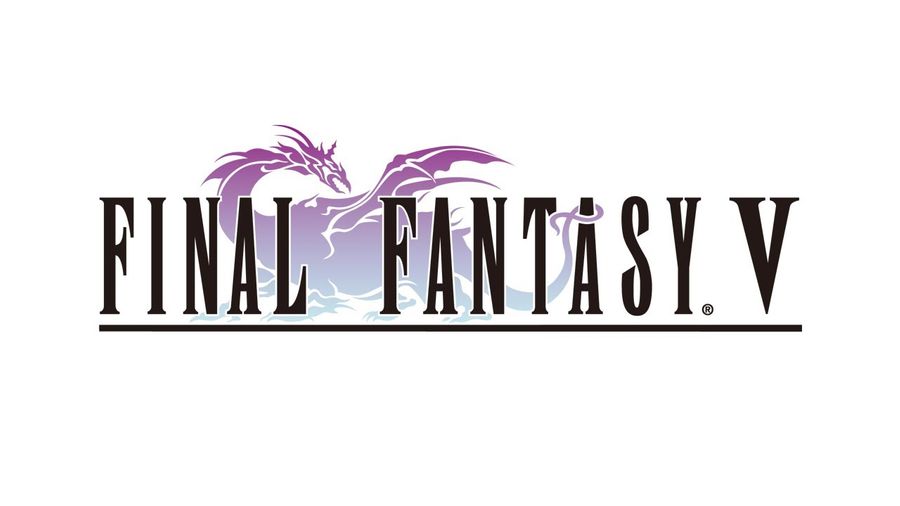It's been awhile since I did one of these, eh?
Full disclaimer, I played the emulated version of the Gameboy Advance port, Final Fantasy V Advance. There is a re-release available on Steam but it features a new visual style which I did not like the look of. The fun pixel art was instead replaced with higher resolution worse pixel art. FFV's original form is a classic and looks like a classic. Allegedly, Final Fantasy V's pixel art was even stolen by Terraria for it's first incarnation. But that's just a game theory.
I would've done this article earlier, but had been dealing with a severe case of writer's block. I am a one man operation and limited sometimes by my own enthusiasm. Sometimes it takes more energy than I'd like to admit to sit down and tap out 2,000 words on video games, sportsball, or wargaming. Even though I really enjoy it.
In a lot of ways, I don't write these articles for the praise. They're a living archive of my thoughts regarding a particular game. How do I know what I thought of Yakuza 0, or the range of casual Mario sports games. Well, it's because they're all here on my blog. Mostly - my blog getting Thanos snapped by my own incompetence didn't help.
When I was younger (but not stupider), I encountered Final Fantasy V on a SNES emulator. At that point I had played Final Fantasy X, but had no respect for the previous games or traditions that Square (now Square Enix, or 'Squenix') had cultivated through falsely titling each game as 'Final Fantasy'.
I thought about that limited time with Final Fantasy V as I obtained a cheaty-face ROM of the game. I thought on how I made decent progress, but eventually found a dead-end I couldn't progress through.
Or so I thought. False memory is a tremendous thing. Turns out I had barely scratched the surface.
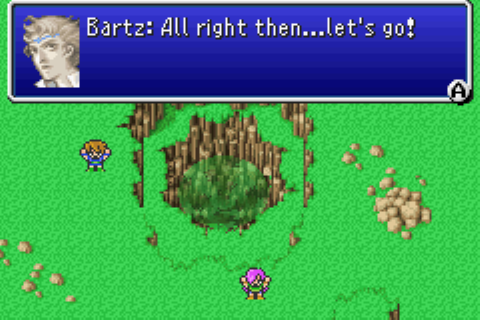
I will try not to spoil the experience, because FFV's plot, like most RPGs, is like Cottees Topping - thick and rich. Even though it's an old game and those who wanted to play it have already played it (yes, in the past I've had a toxic attitude about spoilers, very good). The fact is than an RPG's story is the driving force keeping the player engaged and immersed. Also in many ways, there is only one 'first time' for any video game, but doubly so for RPGs.
I'll try to avoid spilling my spaghetti, but FFV's story is long and in-depth. However, one of FFV's strengths is that it simply told and avoids overcomplication in favor of effective conveyance. Through each of the story acts, I understood where the characters were, what their goals are and generally what needed to happen next. There isn't an abundance of twists, or severe right angles, like, say, Bioshock, but the story isn't predictable.
As a particularly pointed note of praise for FFV, it gives nothing away. The box blurb, the trailer and the intro to the game all explain the story to the player in a way that feels very comprehensive. It's only when you think about how far you've come at the end of the game that you realise just how little you knew at the start. Even in titles where the story is long and in-depth, such as Persona 5 or Yakuza, you have a vague understanding of where the confines of the story can take you. Final Fantasy is nothing like that.
FFV is a totally unique experience in that regard. Even if critical analysis would tell you something different, you'll feel the difference. Even though my playthrough was thirty hours long, it felt longer, giving that feel of a true 'epic' experience.
But about that initial storyline. The introductory cutscene tells a tale of four crystals, representing the elements. Bruce Willis isn't happy about the omission of the fifth element, good thing he's not in this video game. A character by the name of King Tycoon (real name lost to time, but I'm guessing Terence) gets plot-related feels that something has happened to the Wind Crystal. The crystal does what it says on the tin and supplies the world with Wind. The introductory cutscene concludes with meteors crashing to earth. Could the two be related...
We don't find out what happens to the King. Instead we start a new game, stepping into the comfortable shoes and blue tunic of our protagonist, Bartz Klauser. He's known for... nothing in particular, other than he's near the meteorite that landed nearby. Along the way to the meteorite Bartz meets Princess Lenna, who says she is the daughter of King Tycoon. We also meet some old bloke named Galuf, who has lost his memory but is adamant that he needs to go to the same location that Lenna does, and Bartz agrees to accompany them because he doesn't have a lot on, and otherwise there's no video game.
At this point you are introduced to the game's overworld, a delightful pixel art map of the world. In time you'll traverse the land with the help of a number of different vehicles and creatures. For now, you're hoofing it. You'll traverse all manner of terrain in pursuit of your goals, that I won't explain here. This allows the game to have a nice balance of structure and direction (more on that later) and indulging the player's natural desire to quest and explore.
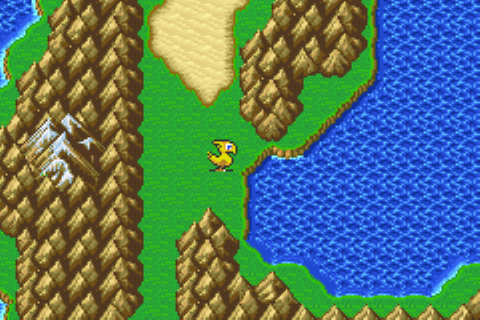
On that topic. Whilst it is totally unfair, Final Fantasy V struggles from a lack of modern design principles. Duh, it's from 1992. As the world opens up, it can be difficult to determine where the game wants to send you next. On more than one occasion I reached the end of a particular story arc and had no indication from the game of where to go next. This is a very personal criticism, though. Other players with a different brain than mine would surey enjoy the complete absence of a guiding hand or supporting documentation to keep the chess pieces being pushed around the board.
Back at the ranch, our heroes Bartz, Lenna and Galuf have themselves the making of a four man party. Eventually you stumble onto the fourth member of your motley crue, Faris. Although initially Faris does try and kidnap you, there's a reaction between a necklace Lenna and Faris share, which convinces her to instead join the cause - which is to go to the Wind Shrine to find King Tycoon.
(I will mention there's a paper-thin sub-plot about Faris being a man which lasts all of about five minutes.)
You reach the Wind Shrine and don't find King Tycoon, but you do find the wind crystal - right before it shatters. Ruh-row It is here, approximately five hours into the game, that you have your first firm understanding of what's going on in the world. The crystals are breaking and it's up to you to stop them doing that, or risk the world descending into non-specific chaos.
I'll leave the story chops there, because at this point you are introduced to Final Fantasy V's signature mechanic - the job system.
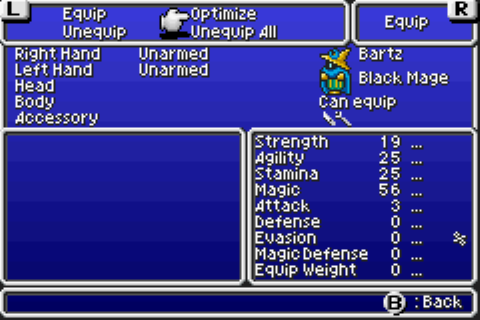
When the wind crystal shattered, our heroes (Bartz, Lenna, Galuf and Faris, in case there's a test later) were empowered with a number of jobs. These allow you to sculpt characters from scratch by having them train in a particular type of job. You can train a character as a Knight, or a White Mage, or a Black Mage, or as a Monk. Each job has an innate ability and stat modifiers - Knights have high strength and vitality (a synonym of health), for example. In addition to the default ability a job has, you can also pick another ability - which can be from a different job.
To give you the example the game itself gives, you can have a Knight character that also uses White Magic to heal their comrades. Nice!
I wasn't kidding about sculpting your characters, either. Once a character trains in a job for long enough, they master it. Mastering a job provides the 'Freelancer' job (the default state of your characters) with the highest base stats amongst mastered jobs, two ability slots and any passive abilities provided by the job. For example, the Ninja job can dual-wield weapons, which is then passed on when mastered. This final translation to a freelancer doesn't happen until very late in the game, but when it does, you'll know what it is to have ultimate power.
This system provides the gameplay with tremendous depth. Through the course of an adventure, the player is encouraged to shift their characters between jobs and adjust how their team functions as a whole. Whilst there are certainly optimal combinations of jobs to create combine-harvester killing machine characters, I never felt the game was so absurdly difficult that I couldn't muddle through with my sub-optimal combination of jobs.
It is also incredibly satisfying to develop a combination of character abilities which works in harmony.
Toward the middle of the game, my fear of missing out did prompt me to google optimal job combinations, but I don't recommend doing this. Knowing what the best combinations of jobs were and what my Freelancer build should look like tens of hours ahead of the endgame did not add to my gameplay experience. It reduced the thrill of discovery to a venture in painting by numbers, or joining the dots.
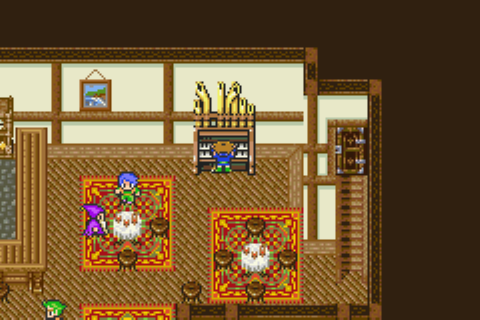
It's a twenty-eight year old RPG. Yes, it's more difficult than a contemporary RPG, but it's not so ball-bustingly hard that you'll give up on the game entirely because you didn't pick the best combination of jobs.
Outside of the job system, it's your standard fare of RPG mechanics. You have three categories of armour - head, chest and accessory. There's some nice nuances in here like different jobs being able to equip specific types of armor and only Freelancers being able to equip the best gear. There's a nice variety of weapon types which are, again, limited by job.
Spells are purchased, rather than learned. Spells are sub-divided into level and discipline, with a few exceptions. This prevents the player from power-leveling a spell-caster and having them carry the party through the game and allows a graceful curve of caster progression. Generally speaking, the levelling is paced nicely with the difficulty of the game - I never felt like I was over- or under-powered at any point. The challenge of the game always seemed to be there, or thereabouts.
FFV's mechanical depth carries into it's broad range of abilities and schools of magic. There's four different schools of magic, each which feel distinct and different to one another. There's the ability to summon monsters, improve your party with songs, enchant weapons with elemental attacks, summon woodland creatures, mind control enemies - the list goes on. There's a lot here - and when coupled with the job system, you'll be hard pressed to be bored by the lack of options at your disposal in any given encounter.
Speaking of encounters, let's talk combat. The first thing to note is that Final Fantasy V uses a 'real-time' system. Each friendly character has an action bar, that allows the character to take an action. This can be a basic attack with an equipped weapon, using magic, using an item, or using an ability. It can also be more esoteric things like using abilities bound to an item, or moving between rows.
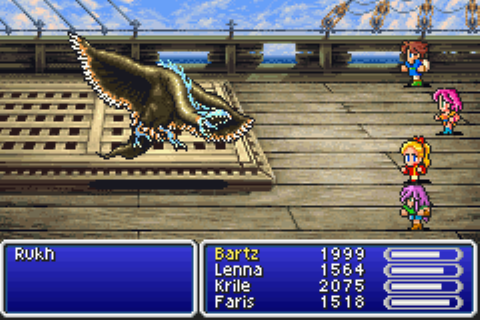
If you've played Chrono Trigger, you know how this works. If you don't, it can be a little awkward and hectic initially, but you'll get the hang of it. I don't think it's better or worse than turn-based combat, only different (thanks, Jaques Pepin). It does open up some interesting design space for boss fights and enemy encounters, which leverage concepts like action economy and time management.
Your characters are also organised in two 'rows'. The back row suffers reduced damage from physical attacks, but also deals reduced damage. It wouldn't be worth mentioning, except that enemies are also organised in the same manner - although it can sometimes be difficult to see who is in front and who is in back when making offensive decisions.
One complaint I do have between all the glowing praise, is the difficulty in seeing (and therefore, keeping track of) buffs and debuffs on enemies and characters. FFV's depth extends to its array of utility spells, which often have no indication in the UI. Friendly characters are less of an issue, but there is an irritating flashing outline of each character when buffed, which can be quite hard to look at.
This mechanically complete gameplay package supports a beautiful triple-a quality pixel art style. The characters and enemies are drawn well, with great depth. A limited palette and low resolution is no obstacle to beauty in Final Fantasy. There's a wide range of environments including temples, caves, castles, dungeons and deserts. The colour palette is vibrant, giving the game an uplifting and joyful feeling. We are a long way from the gritty late 2000s, Toto.
The main character did start to look odd after thirty hours of watching his walk animation. The filter that I put over the emulator for high resolution textures didn't help either. But it's not like Square Enix designed FFV knowing some berk would steal a rom and put it on a PC with a resolution between four and fifty times higher than the platform it was intended for.
Or maybe they did, because FFV would have no problem passing as a strong indie title today. Not with the new art style, mind you, which looks like junk and invalidates all the above praise.
It'd be remiss if I didn't mention the music, but I am not an audiophile. It's not amazing but does it's job well. Props to Squenix for having a variety of battle tracks, which is Persona 5's one weakness. We're a long way off of Yakuza 0, but that is an unreasonably high bar.
Overall, Final Fantasy V is a complete experience. It has strong linear storytelling. It has mechanically deep gameplay, which creates opportunities for replay value. If you can get a copy of FFV Advance, or a SNES, or not the repackaged steam redesign, you'll be in for a treat of an experience.
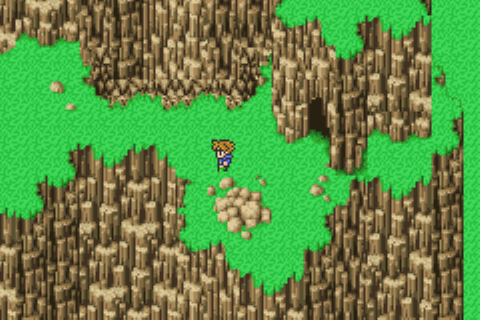
Catch you next time,
Vulkan
Critical Information Summary:
Review Platform: Emulated on Visual Boy Advance
Developer: Square
Publisher: Nintendo
Cost (At Time of Publish): Free. I stole it.
Did you like this article? Did you hate it? Go over and keep the discussion going on the official Vulkan's Corner facebook page! - whilst you're at it, leave a like!
